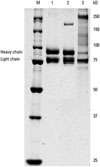1. Kulkarni R, Soucie JM. Pediatric hemophilia: a review. Semin Thromb Hemost. 2011; 37:737–744.

2. Bray GL, Gomperts ED, Courter S, Gruppo R, Gordon EM, Manco-Johnson M, et al. The Recombinate Study Group. A multicenter study of recombinant factor VIII (recombinate): safety, efficacy, and inhibitor risk in previously untreated patients with hemophilia A. Blood. 1994; 83:2428–2435.
3. Lusher JM, Arkin S, Abildgaard CF, Schwartz RS. Kogenate Previously Untreated Patient Study Group. Recombinant factor VIII for the treatment of previously untreated patients with hemophilia A. Safety, efficacy, and development of inhibitors. N Engl J Med. 1993; 328:453–459.

4. Abshire TC, Brackmann HH, Scharrer I, Hoots K, Gazengel C, Powell JS, et al. Sucrose formulated recombinant human antihemophilic factor VIII is safe and efficacious for treatment of hemophilia A in home therapy--International Kogenate-FS Study Group. Thromb Haemost. 2000; 83:811–816.

5. Recht M, Nemes L, Matysiak M, Manco-Johnson M, Lusher J, Smith M, et al. Clinical evaluation of moroctocog alfa (AF-CC), a new generation of B-domain deleted recombinant factor VIII (BDDrFVIII) for treatment of haemophilia A: demonstration of safety, efficacy, and pharmacokinetic equivalence to full-length recombinant factor VIII. Haemophilia. 2009; 15:869–880.

6. Shapiro AD. Anti-hemophilic factor (recombinant), plasma/albumin-free method (octocog-alpha; ADVATE) in the management of hemophilia A. Vasc Health Risk Manag. 2007; 3:555–565.
7. Lentz SR, Misgav M, Ozelo M, Salek SZ, Veljkovic D, Recht M, et al. Results from a large multinational clinical trial (guardian™1) using prophylactic treatment with turoctocog alfa in adolescent and adult patients with severe haemophilia A: safety and efficacy. Haemophilia. 2013; 19:691–697.

8. World Medical Association. World Medical Association Declaration of Helsinki: ethical principles for medical research involving human subjects. JAMA. 2013; 310:2191–2194.
9. Chun BH, Park SY, Chung N, Bang WG. Enhanced production of recombinant B-domain deleted factor VIII from Chinese hamster ovary cells by propionic and butyric acids. Biotechnol Lett. 2003; 25:315–319.
10. Srivastava A, Brewer AK, Mauser-Bunschoten EP, Key NS, Kitchen S, Llinas A, et al. Guidelines for the management of hemophilia. Haemophilia. 2013; 19:e1–e47.

11. Verbruggen B, Novakova I, Wessels H, Boezeman J, van den Berg M, Mauser-Bunschoten E. The Nijmegen modification of the Bethesda assay for factor VIII:C inhibitors: improved specificity and reliability. Thromb Haemost. 1995; 73:247–251.

12. Han H, Shin KH, Paik SH, Chung JY, Lim KS, Cho JY, et al. Pharmacokinetics and Tolerability Evaluation of Human Coagulation Recombinant Factor VIII (GreenGene(TM)) in Hemophilia A Patients. J Korean Soc Clin Pharmacol Ther. 2011; 19:144–151.

13. Paik SH, Kim YJ, Han SK, Kim JM, Huh JW, Park YI. Mixture of three amino acids as stabilizers replacing albumin in lyophilization of new third generation recombinant factor VIII GreenGene F. Biotechnol Prog. 2012; 28:1517–1525.

14. D'Amici GM, Timperio AM, Gevi F, Grazzini G, Zolla L. Recombinant clotting factor VIII concentrates: heterogeneity and high-purity evaluation. Electrophoresis. 2010; 31:2730–2739.
15. Jankowski MA, Patel H, Rouse JC, Marzilli LA, Weston SB, Sharpe PJ. Defining 'full-length' recombinant factor VIII: a comparative structural analysis. Haemophilia. 2007; 13:30–37.

16. Paik SH, Kim YJ, Han SK, Kim JY, Park H, Park YI. Comparability studies of new 3rd generation recombinant human factor VIII GreenGene F after improvement of formulation and viral inactivation/removal process. Biologicals. 2012; 40:405–414.

17. Yoshioka A, Shima M, Fukutake K, Takamatsu J, Shirahata A. Coganate FS Study Group. Safety and efficacy of a new recombinant FVIII formulated with sucrose (rFVIII-FS) in patients with haemophilia A: a long-term, multicentre clinical study in Japan. Haemophilia. 2001; 7:242–249.

18. White GC 2nd, Courter S, Bray GL, Lee M, Gomperts ED. The Recombinate Previously Treated Patient Study Group. A multicenter study of recombinant factor VIII (Recombinate) in previously treated patients with hemophilia A. Thromb Haemost. 1997; 77:660–667.

19. Courter SG, Bedrosian CL. Clinical evaluation of B-domain deleted recombinant factor VIII in previously untreated patients. Semin Hematol. 2001; 38:2 Suppl 4. 52–59.

20. Lee C. The use of recombinant factor VIII products in previously treated patients with hemophilia A: pharmacokinetics, efficacy, safety, and inhibitor development. Semin Thromb Hemost. 2002; 28:241–246.

21. Viuff D, Barrowcliffe T, Saugstrup T, Ezban M, Lillicrap D. International comparative field study of N8 evaluating factor VIII assay performance. Haemophilia. 2011; 17:695–702.

22. Toole JJ, Pittman DD, Orr EC, Murtha P, Wasley LC, Kaufman RJ. A large region (approximately equal to 95 kDa) of human factor VIII is dispensable for in vitro procoagulant activity. Proc Natl Acad Sci U S A. 1986; 83:5939–5942.

23. Gruppo RA, Brown D, Wilkes MM, Navickis RJ. Comparative effectiveness of full-length and B-domain deleted factor VIII for prophylaxis--a meta-analysis. Haemophilia. 2003; 9:251–260.

24. Di Paola J, Smith MP, Klamroth R, Mannucci PM, Kollmer C, Feingold J, et al. ReFacto and Advate: a single-dose, randomized, two-period crossover pharmacokinetics study in subjects with haemophilia A. Haemophilia. 2007; 13:124–130.
25. Kessler CM, Gill JC, White GC 2nd, Shapiro A, Arkin S, Roth DA, et al. B-domain deleted recombinant factor VIII preparations are bioequivalent to a monoclonal antibody purified plasma-derived factor VIII concentrate: a randomized, three-way crossover study. Haemophilia. 2005; 11:84–91.










 PDF
PDF ePub
ePub Citation
Citation Print
Print


 XML Download
XML Download